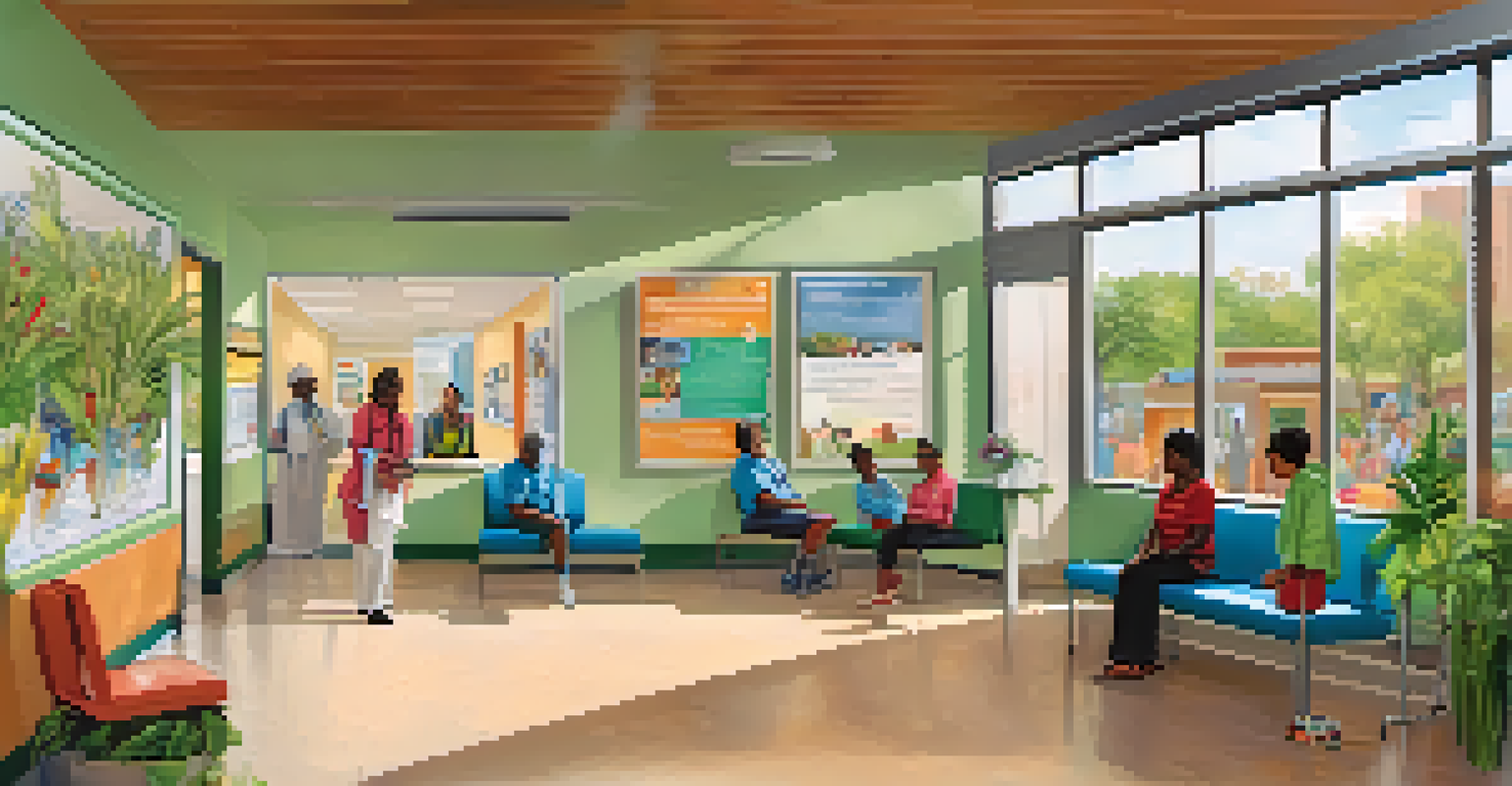The Importance of Community Health Clinics for Underserved Populations

Understanding Community Health Clinics and Their Purpose
Community health clinics are essential healthcare providers that focus on serving underserved populations. These clinics aim to deliver quality medical services regardless of a patient's ability to pay. By offering a range of preventive and primary care services, they play a pivotal role in promoting health equity.
Health is a human right, not a privilege to be bought.
These clinics often operate on a sliding scale, making healthcare accessible to individuals and families who might otherwise avoid seeking medical help. This affordability encourages more people to receive necessary treatments and screenings, contributing to healthier communities. It's like having a safety net that ensures everyone can access the care they need.
Moreover, community health clinics are often located in areas where traditional healthcare facilities are scarce. This strategic placement allows them to reach vulnerable groups effectively, addressing barriers such as distance, transportation, and cost. Ultimately, they serve as a vital bridge between underserved populations and essential health services.
Addressing Health Disparities in Underserved Populations
Health disparities are differences in health outcomes that are closely linked with social, economic, and environmental factors. Underserved populations often experience higher rates of chronic diseases, limited healthcare access, and poorer overall health. Community health clinics are crucial in mitigating these disparities by providing culturally competent care tailored to the specific needs of these groups.

For example, clinics may offer bilingual services or specialized programs for conditions prevalent in certain communities, such as diabetes or hypertension. This targeted approach not only enhances patient understanding but also encourages more individuals to engage with healthcare services. It's all about meeting people where they are and helping them navigate their health journeys.
Community Clinics Promote Health Equity
Community health clinics provide essential medical services to underserved populations, ensuring access to care regardless of a patient's ability to pay.
By focusing on preventive care and education, these clinics empower underserved populations to take charge of their health. When people have access to reliable information and support, they're more likely to adopt healthier lifestyles and seek timely medical attention, ultimately reducing health disparities in their communities.
The Role of Preventive Care in Community Health Clinics
Preventive care is a cornerstone of community health clinics, aiming to catch health issues before they escalate. Services like vaccinations, screenings, and health education are vital for maintaining community well-being. By prioritizing preventive measures, these clinics help reduce the prevalence of diseases and the demand for emergency care.
The greatest wealth is health.
For instance, regular screenings for conditions like high blood pressure or cholesterol can lead to early diagnosis and management. This proactive approach not only saves lives but also lowers healthcare costs in the long run. It's like tuning up a car regularly to prevent breakdowns instead of waiting for a major repair.
Moreover, community health clinics often engage in outreach programs that educate populations about preventive practices. By providing resources and workshops on nutrition, exercise, and mental health, they foster a culture of wellness that extends beyond individual visits. This holistic focus ultimately strengthens the community's overall health.
Mental Health Services in Community Health Clinics
Mental health is just as important as physical health, yet it often goes overlooked, especially in underserved populations. Community health clinics recognize this need and have increasingly integrated mental health services into their offerings. These services can range from counseling to medication management, ensuring comprehensive care.
For many individuals, the stigma surrounding mental health can be a barrier to seeking help. Community health clinics provide a safe, welcoming environment where patients feel comfortable discussing their mental health concerns. It’s like having a trusted friend who listens and supports you through tough times.
Preventive Care is a Key Focus
By emphasizing preventive measures like screenings and health education, community clinics help catch health issues early and reduce overall healthcare costs.
By addressing mental health alongside physical health, clinics promote a more holistic approach to well-being. This integration not only improves individual outcomes but also fosters stronger communities, as people are better equipped to cope with life's challenges and support one another.
Community Engagement and Empowerment Through Clinics
Community health clinics often serve as hubs for engagement and empowerment, bringing people together to foster a sense of belonging. By involving community members in health initiatives, these clinics create a collaborative environment that encourages participation and ownership of health outcomes. It’s like building a supportive neighborhood where everyone contributes to each other's well-being.
Clinics frequently host workshops, health fairs, and support groups that focus on various health topics. These events not only provide valuable information but also help to strengthen community ties. When people come together to learn and share experiences, it fosters a culture of health that extends beyond the clinic walls.
Furthermore, community health clinics often seek feedback from the populations they serve, ensuring that their programs meet the specific needs of the community. This responsiveness builds trust and encourages more individuals to participate in their health journey, ultimately leading to better health outcomes for everyone.
The Impact of Telehealth on Community Health Clinics
Telehealth has revolutionized the way healthcare is delivered, and community health clinics are at the forefront of this change. By utilizing technology, these clinics can reach underserved populations who may face barriers to in-person visits. This includes individuals with mobility issues, those living in remote areas, or those who work irregular hours.
Imagine being able to consult a healthcare provider from the comfort of your home; that’s the convenience telehealth offers. Patients can access medical advice, follow-ups, and even mental health support without the stress of traveling long distances. This flexibility can lead to improved health outcomes, as individuals are more likely to seek care when it’s convenient for them.
Telehealth Expands Access to Care
Telehealth enhances the reach of community health clinics, allowing individuals to access medical services conveniently from home, especially for those facing barriers to in-person visits.
Moreover, telehealth can significantly reduce wait times and increase the efficiency of healthcare delivery. Community health clinics can serve more patients by streamlining appointments and consultations, making it easier for everyone to access the care they need. As technology continues to evolve, the potential for telehealth to enhance community health clinics is immense.
Funding and Support for Community Health Clinics
Funding is a crucial aspect of sustaining community health clinics and ensuring they can serve underserved populations effectively. These clinics often rely on a combination of federal, state, and local funding, as well as grants and donations. Without this financial support, many clinics would struggle to provide essential services to their communities.
For example, the Health Resources and Services Administration (HRSA) provides funding to health centers that deliver care to low-income individuals. This support helps clinics maintain their operations, expand services, and invest in staff training. It’s like having a solid foundation that allows a building to stand tall and strong.

Community involvement also plays a significant role in securing funding for these clinics. When local residents advocate for their health services, it can lead to increased support from government and private organizations. Together, the community and the clinics can create a sustainable model that ensures long-term access to healthcare for all.